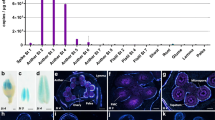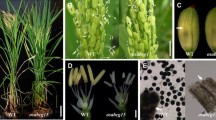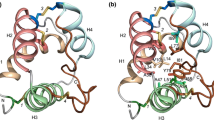Abstract
Key message
A Triticeae type III non-specific lipid transfer protein (nsLTP) was shown for the first time to be translocated from the anther tapetum to the pollen cell wall.
Abstract
Two anther-expressed non-specific lipid transfer proteins (nsLTPs) were identified in triticale (× Triticosecale Wittmack). LTPc3a and LTPc3b contain a putative signal peptide sequence and eight cysteine residues in a C-Xn-C-Xn-CC-Xn-CXC-Xn-C-Xn-C pattern. These proteins belong to the type III class of nsLTPs which are expressed exclusively in the inflorescence of angiosperms. The level of LTPc3 transcript in the anther was highest at the tetrad and uninucleate microspore stages, and absent in mature pollen. In situ hybridization showed that LTPc3 was expressed in the tapetal layer of the developing triticale anther. The expression of the LTPc3 protein peaked at the uninucleate microspore stage, but was also found to be associated with the mature pollen. Accordingly, an LTPc3a::GFP translational fusion expressed in transgenic Brachypodium distachyon first showed activity in the tapetum, then in the anther locule, and later on the mature pollen grain. Altogether, these results represent the first detailed characterization of a Triticeae anther-expressed type III nsLTP with possible roles in pollen cell wall formation.






Similar content being viewed by others
References
Ariizumi T, Toriyama K (2011) Genetic regulation of sporopollenin synthesis and pollen exine development. Annu Rev Plant Biol 62:437–460
Bailey KL, Pitt WM, Leggett F, Sheedy C, Derby J (2011) Determining the infection process of Phoma macrostoma that leads to bioherbicidal activity on broadleaved weeds. Biol Control 59:268–276
Boutrot F, Guirao A, Alary R, Joudrier P, Gautier MF (2005) Wheat non-specific lipid transfer protein genes display a complex pattern of expression in developing seeds. Biochim Biophys Acta 1730:114–125
Boutrot F, Chantret N, Gautier MF (2008) Genome-wide analysis of the rice and Arabidopsis non-specific lipid transfer protein (nsLtp) gene families and identification of wheat nsLtp genes by EST data mining. BMC Genom 9:86
Bragg JN, Wu J, Gordon SP, Guttman ME, Thilmony R, Lazo GR, Gu YQ, Vogel JP (2012) Generation and characterization of the Western Regional Center Brachypodium T-DNA insertional mutant collection. PLoS ONE 7(9):e41916
Briggle LW (1969) Triticale—a review. Crop Sci 9:197–202
Chae K, Gonong BJ, Kim S-C, Kieslich CA, Morikis D, Balasubramanian S, Lord EM (2010) A multifaceted study of stigma/style cysteine-rich adhesin (SCA)-like Arabidopsis lipid transfer proteins (LTPs) suggests diversified roles for these LTPs in plant growth and reproduction. J Exp Bot 61:4277–4290
Chapman BD, Salmon CD, Dyson D, Blackley K (2005) Triticale production and utilization manual. Spring and winter Triticale for grain, forage and value-added. Alberta Agriculture, Food and Rural Development, Edmonton
Cheng HC, Cheng PT, Peng P, Lyu P-C, Sun Y-J (2004) Lipid binding in rice nonspecific lipid transfer protein-1 complexes from Oryza sativa. Protein Sci 13:2304–2315
Crossley SJ, Greenland AJ, Dickinson HG (1995) The characterisation of tapetum-specific cDNAs isolated from a Lilium henryi L. meiocyte subtractive cDNA library. Planta 196:523–529
Dickinson HG, Elleman CJ, Doughty J (2000) Pollen coatings—chimaeric genetics and new functions. Sex Plant Reprod 12:302–309
Dickinson H, Lewis D (1973) The formation of the tryphine coating the pollen grains of Raphanus, and its properties relating to the self-incompatibility system. Proc R Soc Lond Ser B Biol Sci 184:149–165
Edstam MM, Viitanen L, Salminen TA, Edqvist J (2011) Evolutionary history of the non-specific lipid transfer proteins. Mol Plant 4:947–964
Edstam MM, Edqvist J (2014) Involvement of GPI-anchored lipid transfer proteins in the development of seed coats and pollen in Arabidopsis thaliana. Physiol Plant 152:32–42
Fernández Gómez J, Wilson ZA (2014) A barley PHD finger transcription factor that confers male sterility by affecting tapetal development. Plant Biotechnol J 12:765–777
Finkina EI, Melnikova DN, Bogdanov IV, Ovchinnikova TV (2015) Lipid transfer proteins as components of the plant innate immune system: structure, functions, and applications. Acta Naturae 8:47–61
Foster E, Schneiderman D, Cloutier M, Gleddie S, Robert LS (2002) Modifying the pollen coat protein composition in Brassica. Plant J 31:477–486
Fox T, DeBruin J, Haug Collet K, Trimnell M, Clapp J, Leonard A, Li B, Scolaro E, Collinson S, Glassman K, Miller M, Schussler J, Dolan D, Liu L, Gho C, Albertsen M, Loussaert D, Shen B (2017) A single point mutation in Ms44 results in dominant male sterility and improves nitrogen use efficiency in maize. Plant Biotech J 15:942–952
Gómez JF, Talle B, Wilson ZA (2015) Anther and pollen development: a conserved developmental pathway. J Integr Plant Biol 57:876–891
Hihara Y, Hara C, Uchimiya H (1996) Isolation and characterization of two cDNA clones for mRNAs that are abundantly expressed in immature anthers of rice (Oryza sativa L.). Plant Mol Biol 30:1181–1193
Hills MJ, Hall LM, Messenger DF, Graf RJ, Beres BL, Eudes F (2007) Evaluation of crossability between triticale (× Triticosecale Wittmack) and common wheat, durum wheat and rye. Environ Biosaf Res 6:249–257
Horvath BM, Bachem CW, Trindade LM, Oortwijn ME, Visser RG (2002) Expression analysis of a family of nsLTP genes tissue specifically expressed throughout the plant and during potato tuber life cycle. Plant Physiol 129:1494–1506
Huang MD, Chen TL, Huang AHC (2013) Abundant type III lipid transfer proteins in Arabidopsis tapetum are secreted to the locule and become a constituent of the pollen exine. Plant Physiol 163:1218–1229
Jacq A, Pernot C, Martinez Y, Domergue F, Payré B, Jamet E, Burlat V, Pacquit VB (2017) The Arabidopsis lipid transfer protein 2 (AtLTP2) is involved in cuticle-cell wall interface integrity and in etiolated hypocotyl permeability. Front Plant Sci 8:263
Kader JC (1975) Proteins and the intracellular exchange of lipids. I. Stimulation of phospholipid exchange between mitochondria and microsomal fractions by proteins isolated from potato tuber. Biochim Biophys Acta 380:31–44
Kader JC (1996) Lipid-transfer proteins in plants. Annu Rev Plant Physiol Plant Mol Biol 47:627–654
Kalinka A, Achrem M (2018) Reorganization of wheat and rye genomes in octoploid triticale (× Triticosecale). Planta 247:807–829
Khalil HB, Ehdaeivand M, Xu Y, Laroche A, Gulick PJ (2015) Identification and characterization of rye genes not expressed in allohexaploid triticale. BMC Genom 16:281
Koonjul PK, Minhas JS, Nunes C, Sheoran IS, Saini HS (2005) Selective transcriptional down-regulation of anther invertases precedes the failure of pollen development in water-stressed wheat. J Exp Bot 56:179–190
Kouidri A, Whitford R, Suchecki R, Kalashyan E, Baumann U (2018) Genome-wide identification and analysis of non-specific lipid transfer proteins in hexaploid wheat. Sci Rep 8:17087
Kumar S, Stecher G, Tamura K (2016) MEGA7: Molecular evolutionary genetics analysis version 7.0 for bigger datasets. Mol Biol Evol 33:1870–1874
Lauga B, Charbonnel-Campaa L, Combes D (2000) Characterization of MZm3-3, a Zea mays tapetum-specific transcript. Plant Sci 157:65–75
Lee SB, Go YS, Bae HJ, Park JH, Cho SH, Cho HJ, Lee DS, Park OK, Hwang I, Suh MC (2009) Disruption of glycosylphosphatidylinositol-anchored lipid transfer protein gene altered cuticular lipid composition, increased plastoglobules, and enhanced susceptibility to infection by the fungal pathogen Alternaria brassicicola. Plant Physiol 150:42–54
Lévesque-Lemay M, Chabot D, Hubbard K, Chan JK, Miller S, Robert LS (2016) Tapetal oleosins play an essential role in tapetosome formation and protein relocation to the pollen coat. New Phytol 209:691–704
Li J, Gao G, Xu K, Chen B, Yan G, Li F, Qiao J, Zhang T, Wu X (2014) Genome-wide survey and expression analysis of the putative non-specific lipid transfer proteins in Brassica rapa L. PLoS ONE 9:e84556
Liu W, Huang D, Liu K, Hu S, Yu J, Gao G, Song S (2010) Discovery, identification and comparative analysis of non-specific lipid transfer protein (nsLtp) family in Solanaceae. Genom Proteom Bioinformat 8:229–237
Liu F, Zhang X, Lu C, Zeng X, Li Y, Fu D, Wu G (2015) Non-specific lipid transfer proteins in plants: presenting new advances and an integrated functional analysis. J Exp Bot 66:5663–5681
Livak KJ, Schmittgen TD (2001) Analysis of relative gene expression data using real-time quantitative PCR and the 2-ΔΔCt method. Methods 25:402–408
Ma H (2005) Molecular genetic analyses of microsporogenesis and microgametogenesis in flowering plants. Annu Rev Plant Biol 56:393–434
Marchler-Bauer A, Lu S, Anderson JB, Chitsaz F, Derbyshire MK, DeWeese-Scott C, Fong JH, Geer LY, Geer RC, Gonzales NR (2011) CDD: a Conserved Domain Database for the functional annotation of proteins. Nucleic Acids Res 39:225–229
Mizelle MB, Sethi R, Ashton ME, Jensen WA (1989) Development of the pollen grain and tapetum of wheat (Triticum aestivum) in untreated plants and plants treated with chemical hybridizing agent RH0007. Sex Plant Rep 2:231–253
O’Malley RC, Barragan CC, Ecker JR (2015) A user’s guide to the Arabidopsis T-DNA insertion mutant collection. In: Alonso J, Stepanova A (eds) Plant functional genomics. Methods in molecular biology, vol 1284. Humana, New York, pp 323–342
Pacini E (1990) Tapetum and microspore function. In: Blackmore S, Knox RB (eds) Microspores: evolution and ontogeny. Academic Press, London, pp 213–237
Pacini E, Franchi GG (1983) Pollen grain development in Smilax aspera L. and possible functions of the loculus. In: Mulcahy DL, Ottaviano E (eds) Pollen: biology and implications for plant breeding. Elsevier Biomedical, New York, pp 183–190
Pallotta MA, Warner P, Kouidri A, Tucker EJ, Baes M, Suchecki R, Watson-Haigh N, Okada T, Garcia M, Sandhu A, Singh M, Wolters P, Albertsen MC, Cigan AM, Baumann U, Whitford R (2019) Wheat ms5 male-sterility is induced by recessive homeologous A and D genome non-specific lipid transfer proteins. Plant J 99:673–685
Paul W, Hodge R, Smartt S, Draper J, Scott R (1992) The isolation and characterisation of the tapetum-specific Arabidopsis thaliana A9 gene. Plant Mol Biol 19:611–622
Phan HA, Iacuone S, Li SF, Parish RW (2011) The MYB80 transcription factor is required for pollen development and the regulation of tapetal programmed cell death in Arabidopsis thaliana. Plant Cell 23:2209–2224
Piffanelli P, Ross JHE, Murphy DJ (1998) Biogenesis and function of the lipidic structures of pollen grains. Sex Plant Reprod 11:65–80
Rejón JD, Delalande F, Schaeffer-Reiss C, de Dios AJ, Rodríguez-García MI, Van Dorsselaer A, Castro AJ (2016) The pollen coat proteome: at the cutting edge of plant reproduction. Proteomes 4:5. https://doi.org/10.3390/proteomes4010005
Reznickova SA, Dickinson HG (1982) Ultrastructural aspects of storage lipid mobilization in the tapetum of Lilium hybrida var. enchantment. Planta 155:400–408
Rosenberger A (2005) Identification of top-performing cereal cultivars for grain-to-ethanol operations. Zuckerindustrie 130:697–701
Ruzin SE (1999) Plant microtechnique and microscopy. Oxford University Press, New York
Salminen TA, Blomqvist K, Edqvist J (2016) Lipid transfer proteins: classification, nomenclature, structure, and function. Planta 244:971–997
Terras FRG, Goderis IJ, Van Leuven F, Vanderleyden J, Cammue BPA, Broekaert WF (1992) In vitro antifungal activity of radish (Raphanus sativus L.) seed protein homologous to nonspecific lipid transfer proteins. Plant Physiol 100:1055–1058
Tran F, Penniket C, Patel RV, Provart NJ, Laroche A, Rowland O, Robert LS (2013) Developmental transcriptional profiling reveals key insights into Triticeae reproductive development. Plant J 72:971–988
Tucker EJ, Baumann U, Kouidri A, Suchecki R, Baes M, Garcia M, Okada T, Dong C, Wu Y, Sandhu A, Singh M, Langridge P, Wolters P, Albertsen MC, Cigan AM, Whitford R (2017) Molecular identification of the wheat male fertility gene Ms1 and its prospects for hybrid breeding. Nat Commun 8:869
Verma N, Burma PK (2017) Regulation of tapetum-specific A9 promoter by transcription factors AtMYB80, AtMYB1 and AtMYB4 in Arabidopsis thaliana and Nicotiana tabacum. Plant J 92:481–494
Vizcay-Barrena G, Wilson ZA (2006) Altered tapetal PCD and pollen wall development in the Arabidopsis ms1 mutant. J Exp Bot 57:2709–2717
Vinckier S, Smets E (2005) A histological study of microsporogenesis in Tarenna gracilipes (Rubiaceae). Grana 44:30–44
Vogel J, Hill T (2008) High-efficiency Agrobacterium-mediated transformation of Brachypodium distachyon inbred line Bd21-3. Plant Cell Rep 27:471–478
Wang A, Xia Q, Xie W, Datla R, Selvaraj G (2003) The classical Ubisch bodies carry a sporophytically produced structural protein (RAFTIN) that is essential for pollen development. Proc Natl Acad Sci 100:14487–14492
Wang SY, Wu JH, Ng TB, Ye XY, Rao PF (2004) A non-specific lipid transfer protein with antifungal and antibacterial activities from the mung bean. Peptides 25:1235–1242
Wang HW, Hwang SG, Karuppanapandian T, Liu A, Kim W, Jang CS (2012) Insight into the molecular evolution of non-specific lipid transfer proteins via comparative analysis between rice and sorghum. DNA Res 19:179–194
Wang F, Zang XS, Kabir MR, Liu KL, Liu ZS, Ni ZF, Yao YY, Hu ZR, Sun QX, Peng HR (2014) A wheat lipid transfer protein 3 could enhance the basal thermotolerance and oxidative stress resistance of Arabidopsis. Gene 550:18–26
Wang X, Zhou W, Lu Z, Ouyang Y, Yao J (2015) A lipid transfer protein, OsLTPL36, is essential for seed development and seed quality in rice. Plant Sci 239:200–208
Wei K, Zhong X (2014) Non-specific lipid transfer proteins in maize. BMC Plant Biol 14:281
Wu S, O’Leary SJB, Gleddie S, Eudes F, Laroche A, Robert LS (2008) A chalcone synthase-like gene is highly expressed in the tapetum of both wheat (Triticumaestivum L.) and triticale (× Triticosecale Wittmack). Plant Cell Rep 27:1441–1449
Zaidi MA, O'Leary SJ, Wu S, Chabot D, Gleddie S, Laroche A, Eudes F, Robert LS (2017) Investigating Triticeae anther gene promoter activity in transgenic Brachypodium distachyon. Planta 245:385–396
Zaidi MA, O'Leary S, Wu S, Gleddie SC, Eudes F, Laroche A, Robert LS (2012) A molecular and proteomic investigation of proteins rapidly released from triticale pollen upon hydration. Plant Mol Biol 79:101–121
Zhang D, Liang W, Yin C, Zong J, Gu F (2010) OsC6, encoding a lipid transfer protein, is required for postmeiotic anther development in rice. Plant Physiol 154:149–162
Zhang D, Shi J, Yang X (2016) Role of lipid metabolism in plant pollen exine development. Subcell Biochem 86:315–337
Zhang M, Kim Y, Zong J, Lin H, Dievart A, Li H, Zhang D, Liang W (2019) Genome-wide analysis of the barley non-specific lipid transfer protein gene family. Crop J 7:65–76
Author information
Authors and Affiliations
Contributions
MAZ contributed to Western and microscopic analyses, performed Brachypodium transformation, transgenic plant and t-DNA mutant analyses, and contributed to writing the manuscript. SJBO isolated the cDNA clones, performed the northern and in situ hybridization analyses. CG carried out the Western blot analyses. DC and KH contributed to the confocal and electron microscopy work. SW and DH generated the protein fusion in E. coli. FT constructed the vector for plant transformation. DS performed the qRT-PCR experiments and RNA-seq analyses. TV and CS generated the anti-LTPc3 antibody. AL, SG and LSR initiated and supervised the research, and contributed to writing the manuscript.
Corresponding author
Additional information
Communicated by Attila Feher.
Publisher's Note
Springer Nature remains neutral with regard to jurisdictional claims in published maps and institutional affiliations.
Electronic supplementary material
Below is the link to the electronic supplementary material.
Rights and permissions
About this article
Cite this article
Zaidi, M.A., O’Leary, S.J.B., Gagnon, C. et al. A triticale tapetal non-specific lipid transfer protein (nsLTP) is translocated to the pollen cell wall. Plant Cell Rep 39, 1185–1197 (2020). https://doi.org/10.1007/s00299-020-02556-6
Received:
Accepted:
Published:
Issue Date:
DOI: https://doi.org/10.1007/s00299-020-02556-6




